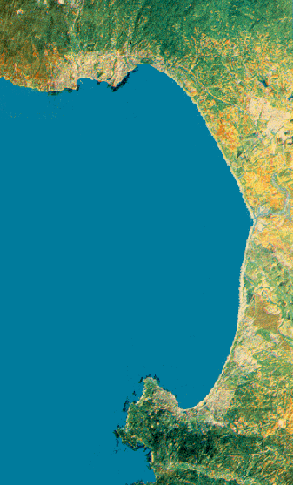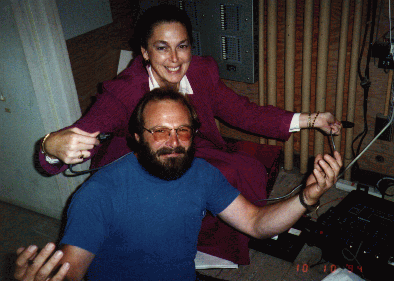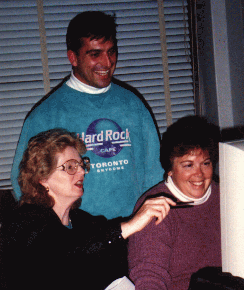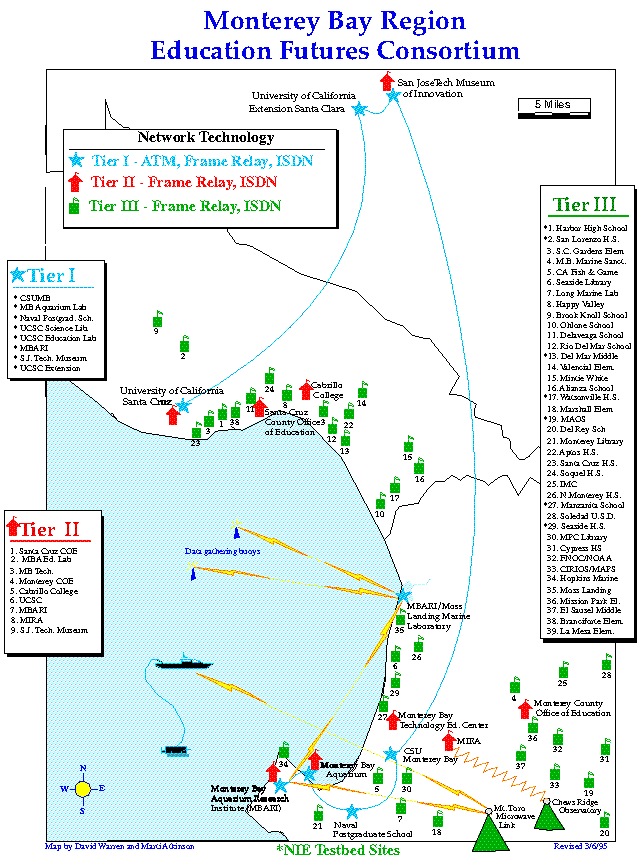Symposium Talks
Networked Ocean Science Research and Education,
Monterey Bay California
Don Brutzman, Ph.D.
Code UW/Br,
Naval Postgraduate School
Monterey, California 93943 USA
408.656.2149 voice, 408.656.3679 fax
brutzman@nps.navy.mil
Don Brutzman's presentation was based on the following paper.
May 12, 1995Abstract
The Monterey BayNet regional network is connecting students, educators, researchers, institutions and individuals around a common theme of environmental and ocean science. A variety of exciting volunteer efforts are building networked information links that can effectively and compatibly operate at low and high speeds. Connectivity, content, access and applications are the four key areas of action. Throughout this large project we have learned that people issues are just as important as technical issues. Our efforts have developed a regional model which effectively supports education at all levels together with the conduct of active scientific research.
Contents
-
2 Connectivity
3 Content
4 Access
5 Applications
6 Lessons Learned, Problems and Future Work
7 Summary
Acknowledgements
References
1 Introduction
A regional network has been constructed to connect K-12 schools, colleges, universities, museums, libraries, government agencies and research institutions in two California counties adjacent to the Monterey Bay National Marine Sanctuary ( Figure 1 ). The network provides researchers, educators and students information access via text, hypertext, multimedia, audio and video. This project is an exciting broad-based collaboration which teams education, science, business and government in an effort to fundamentally improve our schools by connecting teaching with ocean-related research. Our network design approach provides individuals access to any type of live or archived media using a variety of bandwidth rates. Our emphasis has been connectivity, content, access and applications. Our group approach to myriad challenges may be useful to other community networking projects.
1.1 Goals
Specific goals of our regional collaboration are many. From an educational
perspective, we wish to enable teachers and students from kindergarten through
college to have full Internet access. Medium-speed (fractional T1) Internet
access has been provided for 43 schools, libraries and colleges in Monterey
and Santa Cruz counties. From a high-performance networking perspective,
we have connected eight research institutions and universities at ATM speeds
(55 and 155 Mbps). From a research perspective, linkages between schools
and laboratories that work across a variety of architectures and bandwidth
levels are of particular interest. Regional collaboration has worked effectively
at many levels. Taking advantage of our regional strengths has provided
common ground for many diverse interests.

Figure 1. Monterey
Bay, California USA.
1.2 Players
The regional network is the backbone for multiple educational initiatives and research projects. Organization and collaboration are loosely coupled under the local Initiative for Information Infrastructure and Linkage Applications (I3LA) and Monterey Bay Regional Education Futures Group (MBReEF) so that various research efforts are complementary and can leverage past successes. Network bandwidth is provided by Pacific Bell (PacBell) California Research and Education Network (CalREN) grants for Asynchronous Transfer Mode (ATM), Frame Relay (FR) and Integrated Services Digital Network (ISDN) access. The resulting network is called Monterey BayNet. Regional member institution network profiles reveal a spectrum of expertise and interests. Tier I, high-performance ATM sites are producers and consumers of high- bandwidth video and graphics streams. Members include the University of California Santa Cruz (UCSC), UCSC Extension Santa Clara, the Tech Museum of Innovation in San Jose, Monterey Bay Aquarium Research Institute (MBARI), Monterey Bay Aquarium (MBA), California State University Monterey Bay (CSUMB), and the Naval Postgraduate School (NPS). Tier II magnet sites include Cabrillo College, Santa Cruz and Monterey County Offices of Education, the Monterey Peninsula Unified School District (MPUSD) Model Technology Schools Project, the Monterey Institute for Research in Astronomy (MIRA), the Moss Landing Marine Laboratory, and the Monterey Bay National Marine Sanctuary (MBNMS). Tier III sites include over 40 local schools and libraries. Figure 6 shows regional network players. Of particular interest is the development process which emerged during this project. People-related issues were recognized early on as being just as important as technology issues ( Figure 2 ). Tier I sites contributed administrative and technical support to provide initial Internet connectivity to local Tier II and Tier III sites. Zero initial expertise was assumed at Tier II/III sites.
Figure 2. It takes equipment AND people to connect a new school network.
Electronic mail lists proved essential in discussing issues, producing answers and motivating results ( Figure 3 ). Four "tiger teams" work critical issues on a continuing basis: i3la_conacc (information infrastructure content and access), i3la_diglib (digital libraries), i3la_edu (applications for education), and i3la_netdesign (regional network design and management). These "tiger teams" have provided an effective way for people with diverse full-time jobs to volunteer time and effort, benefitting their parent organizations and themselves.
Figure 3. Electronic mail list instructions.
I3LA listserver: mail a message help to majordomo@mbari.org for a list of commands. Message bodies must be written as shown since a program processes these messages. Example message commands:
help
lists
subscribe i3la@mbari.org
subscribe i3la_conacc@mbari.org
subscribe i3la_diglib@mbari.org
subscribe i3la_edu@mbari.org
subscribe i3la_netdesign@mbari.org
info i3la_netdesign@mbari.org
who i3la_edu@mbari.org
unsubscribe i3la@mbari.org
Successes have been attributable to creating sustainable people processes and seeking consensus within active working groups. Although reaching solutions that everyone understands may take longer than might be required if an "expert" came in with a default solution, the process of achieving consensus turns out to be better understood by participants and results in good fits for local needs. Since we are looking to create sustainable processes, an individual sense of ownership and empowerment for each participant is very important.
2 Connectivity
Three tiers of network service connect Monterey Bay I3LA sites. Tier I ATM-level sites are producers and consumers of multiple very high-bandwidth information streams such as video, audio, 3D real-time computer graphics, robot telemetry and environmental datasets. Tier II sites are magnet sites including Monterey and Santa Cruz County Offices of Education with moderately high bandwidth (Frame Relay), serving as example testbeds and training centers. Tier III sites are schools and libraries with lower bandwidth (Frame Relay and eventually ISDN) adequate to provide student users with interactive information access and a single audio/video teleconference ( Figure 6 ).
The net design team has been the single most effective group in I3LA. Getting K-12 students and teachers online has been "job one." Network design, configuration and installation has been a 20-month volunteer effort. Much of this time was due to teaching and learning the numerous concepts and issues involved in local and wide area network design. School walkthroughs and site inspections were an essential part of this effort. Computer science students, network engineers and interested educators learned the idiosyncrasies of ATM, Frame Relay and ISDN service offerings. A close partnership with PacBell provided additional expertise and support when needed. A recommended set of configurations for PCs, Macintoshes, interface cards, hubs, routers and servers was produced to provide clear guidelines for schools which are planning and financing new network connections. Occasionally group purchases have been able to reduce cost and stretch precious education dollars.
County offices of education in Monterey and Santa Cruz now find themselves growing into a service provider role. The critical reference guiding this transition has been the California Department of Education K-12 Network Technology Planning Guide [1] . Student teams from the Naval Postgraduate School and Cabrillo College have provided essential manpower in implementing design plans and providing interim network information and operations support. Student support has been enthusiastic due to the opportunity to work on real-world problems of great personal and professional value [2] [3].
3 Content
As is happening in many places around the Internet, our regional institutions are putting existing knowledge resources online and developing new ways of accessing them. A frequent common denominator is to provide context through HyperText Markup Language (html) pages ( Figure 4 ). Other advanced hypermedia interfaces have been adapted for accessing very large environmental datasets and archived visualizations. The Multicast Backbone (MBone) is being used to multicast educational courses with worldwide scope, followed by audio/video archiving for digital video retrieval on demand [4] [5] . Online multimedia design courses at the University of California Santa Cruz (UCSC) are challenging college students to provide easy and effective templates for new K-12 schools to use. Additionally students and teachers are discovering for themselves how to publish information content on the Web, often discovering new innovations in the process.Figure 4. Pointers for regional research and education home pages, providing context for archived content.
- Learning About Monterey Bay (LAMBAY), http://lambay.cse.ucsc.edu/mb
- Monterey Bay Regional Education Futures (MBReEF) Consortium, http://www.ucsc.edu/mbay-region
- Initiative for Information Infrastructure & Linkage Applications (I3LA), ftp://taurus.cs.nps.navy.mil/pub/i3la/i3la.html
- Real-time Environmental Information Network & Analysis System (REINAS), http://csl.cse.ucsc.edu/reinas.html
The content and access (conacc) tiger team is focused on helping make pertinent data, information, and knowledge resources available for the environmental activities of students, educators, resource managers and researchers. The tiger team is paying special attention to the immediate needs of regional application exemplars. They are also identifying and filling gaps in the data, information and knowledge needed to link students to researchers, researchers to resource managers, educators to researchers and resource managers, and students to students.
Guiding principles of the conacc team are that an environmental information infrastructure includes ubiquitous connectivity, pertinent content, effective access, and applications targeted to specific user groups. Content will include existing scientific environmental data; information in the form of traditional publications, bulletin boards and mailing list servers; information in new forms such as multimedia curricula, scientific visualizations and electronic representations of conceptual ideas; and knowledge resources such as "ask the expert" forums and video teleconferencing services. Equitable access implies that the content of critical applications will have to be usable in different modes and across generations of technology with different levels of capability. We want to prevent developing an "information have/have-not society." Effective content access also implies that information retrieval is pertinent, relevant to users' specific needs, authentic and of high quality. Thus the overall connectivity, content, access and applications model provides a clear framework for action from both individual and group perspectives.
4 Access
Computer equipment has been provided independently by member institutions with an emphasis on using personal computers or workstations capable of audio, video and hypermedia as a baseline common denominator. In most instances the schools had at least one Macintosh or PC that was suitable. Not all schools fit in this category, but initial school involvement in this project was voluntary so most had some computer experience. Schools uniformly had to pay additional funds for routers and adapter cards.
Use of freely available videoconferencing and hypermedia software applications (e.g. tools for the Multicast Backbone [4] and the World-Wide Web [6] ) has provided an immediate and well-understood path for complete connectivity to a wide variety of existing information sources. We have followed the Internet model in order to include all types of media as well as all types of people. We did NOT propose any brand new technical or engineering study because open solutions already exist. The intellectual forces and market forces driving the Internet now have an irresistible momentum. Software tools freely available on the network are often superior to commercial tools due to active research communities, rapid feedback correction, zero dollar cost to users, and portability over most hardware/operating system architectures. Because the delivery of information content must be rapid enough to stimulate student interest, we are connecting at bandwidth levels adequate for educational videoconferencing. We want students and other people to be able to interact with scientists, educators and each other to maximize learning and the discovery process ( Figure 5 ).

Figure 5. Once
they have connectivity, educators only need a little time to access real
content and put it to use.
The Multicast Backbone tools provide audio and video across the Internet in a way that conserves bandwidth and scales up. Multicast lets a single information stream (such as video) touch multiple receiving machines, and also lets receiving machines ignore unwanted packets at the hardware level instead of wasting processor cycles deciding whether or not a given packet is of interest. Although tools are just beginning to be ported to PC and Macintosh architectures, we are practicing delivery of conferences and classes with regional and world-wide scope using a variety of workstation architectures [7] [8] . We expect MBone use to eventually be widespread for PCs and Macintoshes.
College student volunteers have been installing network connections, upgrading personal computers and configuring host systems in regional schools. There is now a large number of qualified participants who can effectively teach others how to install and use the network. Existing school computer equipment has been used only when it meets minimum standards for World-Wide Web (WWW) audio and image access. Predictable network performance and reasonable maintainability has been attained through group buys of identical routers and network interface cards.
Ultimately, we want to enable widespread information access by making it easy for students and educators to create their own home pages. This makes new study connections possible for everyone. It also provides identical solutions for children whether at home or at school. We hope that many parents will be willing to help this project when they see that they can access and reinforce their childrens' curricula and projects. Thus we have created a set of distribution diskettes containing free and shareware software tools. This software set is installed at each school. Copies and updates are conveniently available over Internet connections via home pages. Software costs have thus been reduced to the bare minimum while still observing copyright and intellectual property restrictions.
5 Applications
Education exemplars include the live exploration of Monterey Canyon using a deep remotely-operated vehicle, a "virtual canyon" science archive, a "virtual telescope" interface to astronomical data collected by the Monterey Institute for Research in Astronomy (MIRA), and a "watershed" project which explores the hydrographic relationships between agriculture, estuaries, cities and Monterey Bay.
BayLink connects the auditorium at the Monterey Bay Aquarium to remote sites via live audio and full frame-rate video over ATM. Four days each week an experienced "linker" guide interprets scientific missions in progress to aquarium audiences. Live science is supplemented by a videodisc collection covering 300 different clips about Monterey Bay biology, oceanography and geology. Addition of BayLink permits group interaction with remote auditoria at the San Jose Tech Museum of Innovation and elsewhere.
The Virtual Canyon project is another "virtual field trip" designed to bring innovative applications directly to students. A large collection of interpreted videos, images and presentations are being archived in videotape, videodisc and online hypermedia formats. Putting a "scientist in a box" and making ocean science content available in a form accessible by any school will supplement curricula regardless of their school's connectivity. Students will be able to conduct their own research on deep-sea habitats, creating their own individual papers and field trips, and (on occasion) publishing them electronically.
MIRA's Field Trip to the Stars uses a Virtual Telescope to provide students with Internet access to 100 gigabytes of archived astronomical imagery. Students will be able to browse through massive image archives as if steering a telescope unaffected by time of day or weather. A remote telescope control interface will permit qualified students to schedule actual telescope observations as well as interact with NASA and other networked electronic telescopes around the world. Structured instruction designed around key themes will provide a supplement to standard science curricula. Addition of an Artificial Neural Network Intelligent Teaching Assistant (ANNITA) will provide an innovative intelligent tutoring system.
The Watershed Project involves students with the Monterey Bay National Marine Sanctuary in assessing and monitoring water quality. Data is collected from surface and groundwater samples, from biological monitoring of aquatic insects and fish, and from analysis of interactions involving the agriculture industry, estuaries and cities ringing Monterey Bay. Students interact with scientists and each other as they participate in monitoring the watershed.
A variety of other new applications (such as networked robots and large-scale virtual worlds [9] ) are being planned and implemented to take advantage of the significant capabilities offered by the Monterey BayNet regional education network.
6 Lessons Learned, Problems and Future Work
We have had many lessons learned. First, people issues are always as important as technical issues. You cannot build a network if no one understands what is going on. Second, everything takes three times longer than expected. Despite what we believed were conservative time estimates, it took almost twenty months to go from initial conception to actual students sitting at actual keyboards "surfing the Web" in their schools. Hundreds of hours have been invested in analyzing objectives, writing grants and developing new interinstitutional research relationships. Hopefully our successors can use some of our results and won't need as long. Finally, participatory ownership produces sustainable results. It is not enough to get things working for a week or two. People have to be involved in their own destiny throughout the process so that they understand the costs, benefits and time commitments.
A number of things that we tried just didn't succeed. Despite recurring attempts to attract corporate sponsorship and cooperative business partners, funding for new school equipment has been mainly from strained local budgets. Formal memoranda of agreement between member institutions remain conceptually appealing but difficult to implement. Intellectual property issues still restrict access to some scientific data and curriculum materials. Key players have been so busy establishing the current network that new schools are becoming ready to join faster than can be practically supported. Long-term funding mechanisms are not clear, especially when CalREN-sponsored network access runs out.
Future efforts include establishing routine ways for new individuals and schools to get involved and get connected. Establishing sustainable funding and training mechanisms is believed essential for educational network growth and sustainability. We now understand why funded Network Information Center (NIC) and Network Operations Center (NOC) support are so important, and we are working to move from ad hoc support to a properly staffed NIC/NOC operation. We hope to develop better ways of getting useful computers into the schools, and business partners are especially welcome to work with us in this area. We expect to learn more lessons and continue working on new problems as we pursue our long-term goals of educating real students while conducting real science.
Our next event is SIGGRAPH in August 95 [10] when we will enable educators in our area to connect remotely to SIGGRAPH and SIGKIDS Interactive Communities exhibits. The objective is to provide teachers new to the Internet with a series of lively projects that can help them learn firsthand how to use the Internet in their classes. We expect to give them access to interesting projects, collaborators, and a "SIGGRAPH TV" channel over the MBone.
As always, our goals are first to open doors for education and science, and then to get out of the way so people can get to work. We are excited by the many great opportunities which Monterey BayNet has brought. Throughout this process, individuals have found that they get back much more than they can put in. We will continue working at the grass-roots level, and we welcome participation by other interested individuals and groups.
7 Summary
If we look from one end to the other at the overall problem of connecting live science to students, we find that this group is working to put all of the pieces in place. We have science, scientists and educators working on the shared natural resource of Monterey Bay in a variety of disciplines. We have bandwidth from grants to enable interactive transfer rates. We have locations where students and public can best be served by connecting to these resources. We have a coherent model based on the Internet that has already solved the software and hardware problems associated with wide-area multimedia distribution. We have a sensible vision which is putting all of these pieces together in a dynamic and exciting way. Our planned graduation exercise is an International Conference on the Environment and Education in summer 1996. We invite others to collaborate with these compelling efforts and take advantage of the "lessons learned" described here.
Acknowledgements
This paper describes the efforts of over a hundred people. Network design and deployment to date has taken over 7000 volunteer hours. Our prime mover is Bruce Gritton of MBARI who brought together the original key players and has sustained the vision of connectivity, content, access and applications that works so well. On behalf of the students and teachers of Monterey and Santa Cruz Counties, I thank Marti Atkinson, Rowland Baker, Pat Barrett, Jim Bellamy, Carl Berman, Roger Born, Peter Brewer, Jeff Bryant, Rex Buddenberg, Jon Bigelow, Jan Dickens, Bob Ellis, Tracey Emswiler, Heather Forsythe, J.J. Garcia-Luna, Nancy Giberson, Bruce Gritton, Mike Herbst, Tom Hoskins, Birt Johnson, Frank Kelbe, Syd Leung, Brian Lloyd, Mike Macedonia, Pat Mantey, Lora Lee Martin, Kam Matray, Jim May, Mike McCann, Peter McMillan, Mike Mellon, RADM Thomas Mercer USN, Katie Muir, Mike Newman, David Norman, Maxine Reneker, Deborah Richards, Greg Scott, Gary Sharp, Fred Siff, Jon Spear, Brian Steckler, Trish Stoddart, Chris Taylor, Dennis Trepanier, Jim Warner, David Warren, Steve Watkins, Bruce Weaver, Steve Webster, the David and Lucille Packard Foundation, and the many enthusiastic people working in the I3LA tiger teams.
References
[1] Building the Future: K-12 Network Technology Planning
Guide , California Department of Education, Sacramento California, 1994.
Ordering information at 1.800.995.4099 or 1.916.445.1260
[2] Trepanier, Dennis, Buddenberg, Rex et al., The
Initiative for Information Infrastructure and Linkage Applications (I3LA)
Network: Physical Configuration Team Project , Naval Postgraduate School,
Monterey California, April 1995.
[3] Bigelow, Jon, Internetworking: A Case Study in
Planning and Implementing a WAN, Master's Thesis, Naval Postgraduate
School, Monterey California, June 95.
[4] Macedonia, Michael R. and Brutzman, Donald P., "MBone
Provides Audio and Video Across the Internet," IEEE COMPUTER
, April 1994, pp. 30-36. ftp://taurus.cs.nps.navy.mil/pub/i3la/mbone.html
[5] Rhyne, Theresa Marie, Brett, George, Brutzman, Don,
Cox, Donna J. and Santos, Adelino, "Exploiting Networks for Visualization
and Collaboration: No Network Roadblocks?," discussion panel, Association
for Computing Machinery (ACM) Special Interest Group on Computer Graphics
(SIGGRAPH) 94 , Orlando Florida, July 24-29 1994, pp. 481-482.
[6] Hughes, Kevin, "Entering the World-Wide Web
(WWW): A Guide to Cyberspace," Enterprise Integration Technology Inc.,
May 1994, http://www.eit.com/web/www.guide/
[7] Brutzman, Don and Paxinos, Garry M., "MBone
at SIGGRAPH 94," COMPUTER GRAPHICS , December 1994.
[8] Emswiler, Tracey, Using the Multicast Backbone
(MBone) for Distance Learning: A Case Study, Master's Thesis, Naval
Postgraduate School, Monterey California, September 95.
[9] Brutzman, Donald P., "A Virtual World for an
Autonomous Underwater Vehicle," Visual Proceedings, Association
for Computing Machinery (ACM) Special Interest Group on Computer Graphics
(SIGGRAPH) 94 , Orlando Florida, July 24-29 1994, pp. 204-205.
[10] Brutzman, Don, "Remote Collaboration with
Monterey Bay Educators," Visual Proceedings, Association for Computing
Machinery (ACM) Special Interest Group on Computer Graphics (SIGGRAPH) 95
, Los Angeles California, August 7-11 1995.
Author Information
Don Brutzman is a computer scientist working in the Interdisciplinary Academic Group at the Naval Postgraduate School. His research interests include underwater robotics, real-time 3D computer graphics, artificial intelligence and high-performance networking. He is a member of the Institute of Electrical and Electronic Engineers (IEEE), Association for Computing Machinery (ACM) Special Interest Group on Graphics (SIGGRAPH), the American Association for Artificial Intelligence (AAAI), the Marine Technology Society (MTS) and the Internet Society (ISOC).
Figure 6. Monterey BayNet member sites.
Don Brutzman http://faculty.nps.edu/brutzman/brutzman.html
mailto:brutzman@nps.navy.mil
